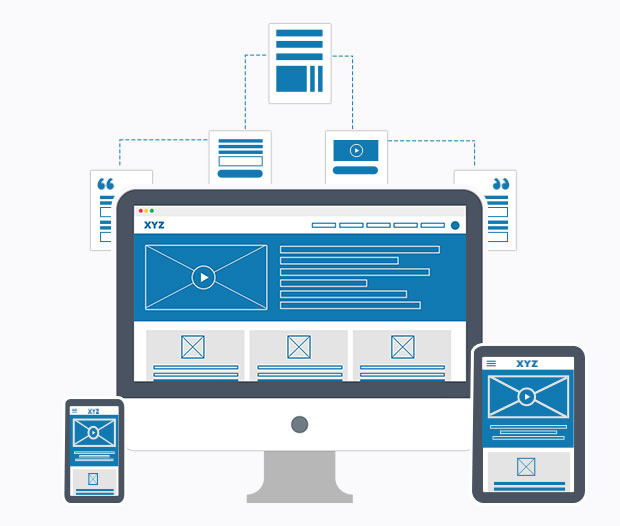
Information Architecture & User Experience
Information architecture (IA) focuses on organizing, structuring, and labelling content in an effective and sustainable way. The goal is to help users find information and complete tasks. To do this, you need to understand how the pieces fit together to create the larger picture, how items relate to each other within the system. IA is to help users understand where they are, what they’ve found, what’s around, and what to expect. It focuses on the organization and structure of content in a manner in which a user can navigate through it.
User Experience (UX) is the way a person feels about using a product, system or service. This includes a person’s perceptions of the practical aspects such as utility, ease of use and efficiency of the system. User Experience takes Information Architecture as its foundation and brings it to the next level.
Our UX experts provide detailed blueprints for high-performance websites. What architects do for buildings, we (as information architects) do for websites, software and interactive services.
This is What We Help You with:
- Categorize, structure and represent information with relevant content for your target audience.
- Optimizing users’ pathways through the information space by using existing analytic and behavioural data to siphon users precisely where you want them, thus, leading to increase in conversions and ROI and enhance user experience of navigating through a well thought-out website with clear avenues for inquiry and action.
- We are 'bridge-builders' who help enhance the overall user experience. We build bridges between:
- Users and Content
- Strategy and Tactics
- Units and Disciplines
- Platforms and Channels
- Research and Practice
Websites without a plan grow into big messes, which lead to:
- Usability and Findability disasters
- Content Management Nightmares
- Costly Redesigns
The Key Principles of Information Architecture & User Experience
Organization Schemes and Structures: How You Categorize and Structure Information
Organization systems are composed of organization schemes and organization structures. An organization scheme defines the shared characteristics of content items and influences the logical grouping of those items. An organization structure defines the types of relationships between content items and groups. Information should be organized in such a way which provides ease of access to the users so that they can find the right answers to their questions. We should strive to support casual browsing and directed searching. Our aim is to design organization and labelling systems that make sense to users. We can apply multiple organization systems to the same content and escape the physical limitations of the print world.
Labelling Systems: How You Represent Information
Labels come into the picture when we need to represent large chunks of data with few words. Just as we use spoken words to represent concepts and thoughts, we use labels to represent larger chunks of information in our web sites. When we “converse” with users through the web sites, the feedback isn’t quite so immediate and the site serves as an intermediary that slowly translates messages from the site’s owners to users, and back again. Hence, in order to minimize this disconnect, labels should be designed in such a way that speak the same language as a site’s users while reflecting its content. Labels should educate users about new concepts and help them quickly identify familiar ones. Finally, remember that as labels represent a relationship between two things - users and content - that is constantly morphing, the labelling system needs to be tweaked and improved as necessary.
Navigation Systems: How Users Browse or Move through Information
If your site cannot be browsed with ease, relevant content on your site alone will be unable to retain visitors on your site. Navigation tools were created to prevent us from getting lost and to help us find our way home. Same way, consistent navigation helps the visitors to explore your online business with ease. Hence, this is the first step towards gaining their trust which eventually brings them back to the site, and get them to convert. While a well-designed taxonomy may reduce the chances that users will become lost, complementary navigation tools are often needed to provide context and to allow for greater flexibility. Structure and organization are about building rooms. Navigation design is about adding doors and windows. If your website contains overwhelming information, or offers too many choices to your visitors, it is bound to confuse the visitors and they will exit your website and find a competitor's site that is easier to browse. Minimalist design can achieve beautiful results and its whole purpose is to make the content stand out and be the focal point. If a page has too many elements, the viewer will be confused about where to look or misinterpret the priority of each element. A minimalist design puts the focus squarely on the content.
Always remember:
"Brevity is the soul of wit." ~ William Shakespeare
"Brevity is a great charm of eloquence." ~ Cicero
Search Systems: How Users Look for Information
A search system is not a replacement for having a good navigation system. Your site should, of course, support the finding of its information but there are other ways for the same. Be careful not to presume that a search engine alone will satisfy all users' information needs. While many users want to search a site, some are natural browsers, preferring to forego filling in that little search box and hitting the "search" button. We suggest you consider the following questions before committing to a search system for your site:
- Does your site have enough content?
- Will investing in search systems divert resources from more useful navigation systems?
- Do you have the time and know-how to optimize your site’s search system?
- Are there better alternatives?
- Will your site’s users bother with search?

